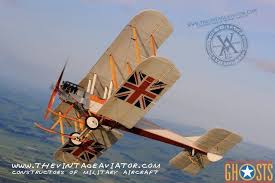
1914-1915 Replacing the horse
When war was declared in August 1914, the deployment of ‘new-fangled’ flying machines on the battlefield was viewed with considerable scepticism by most of the warring nations’ military high-rankers. Yet in a ‘Great War’ that was to see major technological advances in weaponry: submarines, tanks, machine guns and heavy artillery, the opening months of World War One were frequent witness to outdated concepts: cavalry charges were commonplace.
 Certain far-sighted visionaries however saw in both aeroplanes and airships a means of achieving a great tactical advantage. Despite the low performance of the early monoplanes and biplanes, they were nevertheless considerably faster than cavalry, could cover far broader fields of operation and, crucially, enjoyed an unrivalled view of the battle lines.
Certain far-sighted visionaries however saw in both aeroplanes and airships a means of achieving a great tactical advantage. Despite the low performance of the early monoplanes and biplanes, they were nevertheless considerably faster than cavalry, could cover far broader fields of operation and, crucially, enjoyed an unrivalled view of the battle lines.
From the outset, their value as reconnaissance vehicles to monitor troop movements was recognised and despite their activities often curtailed by bad weather and accidents, they soon proved their worth. Indeed aerial observation by aeroplanes and airships had a far-reaching impact on a number of the war’s early decisive ground battles.
The opposing armies soon began to ‘dig-in’ to prevent themselves being outflanked and a sinuous network of trenches spread outwards from the Western Front. Stretching from the Channel coast near Nieuport all the way to the neutral Swiss frontier, it resulted in a deadly stalemate that lasted until 1918. With the advent of trench warfare, the days of cavalry-led reconnaissance were at an end. Now the aeroplane would take over that vital role.
